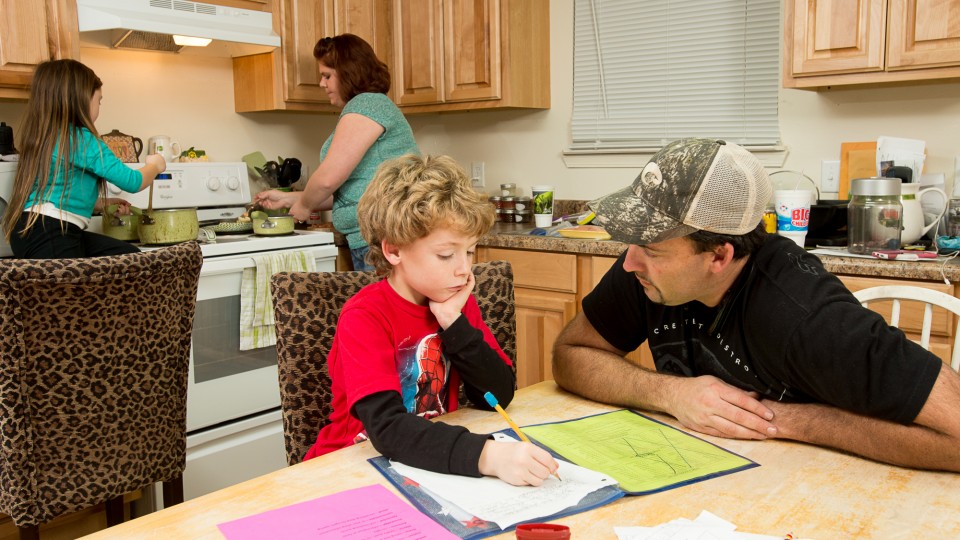What happened when a school assigned less homework?
- March 28, 2016
- / Reggie Dogan
- / education

The Herrman family gets ready for dinner while doing homework at their home in Milton, Fl., Thursday, January
16, 2015. From left, Bryleigh,4, Tiffanny, Waylon,7, and Kevin. (Michael Spooneybarger/ Pensacola Today)
I recently attended a student-led conference with my 10-year-old son and politely complained to the teacher that she didn’t assign enough homework.
Two years ago, I thought his second-grade teacher gave too much homework.
How much homework is too much?
Both the National PTA and the National Education Association endorse the 10-minute rule, which says the maximum amount of homework should not exceed 10 minutes per grade level per night.
That means a fourth-grader (like my son) should have no more than 40 minutes of homework a night.
But a study recently published in The American Journal of Family Therapy, found students in the early elementary school years are getting significantly more homework than is recommended by education leaders, in some cases nearly three times as much homework as is recommended.
In a Washington Post blog, “Principal: What happened when my school ended useless homework,” Valerie Strauss writes about a Cambridge, Mass., principal who re-evaluated the importance of homework.
Katie Charner-Laird, principal of Cambridgeport School, educates students from what she calls “junior kindergarten” through fifth grade.
Charner-Laird detailed what happened at her school when she led a team of teachers to reexamine homework and whether it was important to assign.
Charner-Laird wrote:
I read a number of articles about how we have to get better at homework, the argument being that homework is a problem for children and families because it is tedious and doesn’t ask children to think critically and creatively. While I didn’t completely disagree with these articles, I also didn’t find a strong rationale for why we give homework or how much homework we should be giving.
Instead of assigning homework, the teachers encouraged parents to spend more time with their children reading, playing games and talking, and homework became family time spent together.
The results were revealing: Teachers had more time to plan creatively for classroom work; students began to enjoy the work at home with family; and parents became more engaged in the learning process because they actually had a role in planning and assigning the “homework.”
Charner Laird concluded:
So in 2014, Cambridgeport became “the school that doesn’t give homework,” yet I heard repeatedly from students, teachers, and parents about the significant, meaningful work they are doing at home. A fourth grader begged to take home his writing book notebook on the third day of school so he could keep working on the story he had started in class. A class of fifth graders requested additional practice problems to take home with them. A father-daughter pair showed me the model they created of the setting of the book they were reading together.
Our school may be giving less homework but we have more students engaged in more meaningful learning activities at home than ever before.
Do you think kids get too much or too little homework? Share your thoughts on Twitter.com/StuderInstitute or Facebook.com/StuderInstitute.
 CivicCon launches with a look at good growth in cities
CivicCon launches with a look at good growth in cities
 Building stronger brains one baby, one parent at a time
Building stronger brains one baby, one parent at a time
 SCI debuts commercial on Early Learning City
SCI debuts commercial on Early Learning City
 Entrecon: World class speakers and an opportunity to sharpen skills
Entrecon: World class speakers and an opportunity to sharpen skills
 PYP Quality of Life survey 2017
PYP Quality of Life survey 2017
 EntreCon Pensacola 2016: A look back
EntreCon Pensacola 2016: A look back
 Leadership tip: getting better employee takeaways
Leadership tip: getting better employee takeaways
 Leadership tip: be interested instead of interesting
Leadership tip: be interested instead of interesting
 Leadership tip: delivering difficult messages
Leadership tip: delivering difficult messages
 Brain Bags boost Arc, Early Childhood Court programs
Brain Bags boost Arc, Early Childhood Court programs